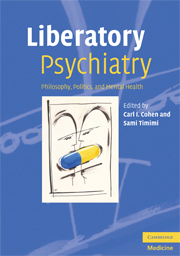Book contents
- Frontmatter
- Contents
- Contributors
- Acknowledgments
- Introduction
- 1 Working towards a liberatory psychiatry? Radicalizing the science of human psychology and behavior
- 2 Power, freedom, and mental health: a postpsychiatry perspective
- 3 Challenging risk: a critique of defensive practice
- 4 Democracy in psychiatry: or why psychiatry needs a new constitution
- 5 German critical psychology as emancipatory psychology
- 6 Psychopolitical validity in the helping professions: applications to research, interventions, case conceptualization, and therapy
- 7 Class exploitation and psychiatric disorders: from status syndrome to capitalist syndrome
- 8 Ecological, individual, ecological? Moving public health psychiatry into a new era
- 9 Children's mental health and the global market: an ecological analysis
- 10 Postcolonial psychiatry: the Empire strikes back? Or, the untapped promise of multiculturalism
- 11 A new psychiatry for a new world: postcolonialism, postmodernism, and the integration of premodern thought into psychiatry
- 12 Neoliberalism and biopsychiatry: a marriage of convenience
- 13 Psychoanalysis and social change: the Latin American experience
- 14 A new psychiatry?
- Index
- References
11 - A new psychiatry for a new world: postcolonialism, postmodernism, and the integration of premodern thought into psychiatry
Published online by Cambridge University Press: 25 August 2009
- Frontmatter
- Contents
- Contributors
- Acknowledgments
- Introduction
- 1 Working towards a liberatory psychiatry? Radicalizing the science of human psychology and behavior
- 2 Power, freedom, and mental health: a postpsychiatry perspective
- 3 Challenging risk: a critique of defensive practice
- 4 Democracy in psychiatry: or why psychiatry needs a new constitution
- 5 German critical psychology as emancipatory psychology
- 6 Psychopolitical validity in the helping professions: applications to research, interventions, case conceptualization, and therapy
- 7 Class exploitation and psychiatric disorders: from status syndrome to capitalist syndrome
- 8 Ecological, individual, ecological? Moving public health psychiatry into a new era
- 9 Children's mental health and the global market: an ecological analysis
- 10 Postcolonial psychiatry: the Empire strikes back? Or, the untapped promise of multiculturalism
- 11 A new psychiatry for a new world: postcolonialism, postmodernism, and the integration of premodern thought into psychiatry
- 12 Neoliberalism and biopsychiatry: a marriage of convenience
- 13 Psychoanalysis and social change: the Latin American experience
- 14 A new psychiatry?
- Index
- References
Summary
Introduction
In conceptualizing a new psychiatry for a new world, the authors found themselves having points of similarity as well as points of departure. They quickly realized that their differing viewpoints were influenced significantly by their backgrounds, their parent cultures, their adopted ones – in essence, their histories. This undoubtedly had an effect on the way this chapter was written. The aforementioned points of departure rendered a single chapter in a single voice an impossibility.
Instead, we are presenting three individually written essays. These essays contain as their organizing themes (in sequence) a postcolonial perspective, postmodern analysis, and an integration of premodern thoughts in contemporary psychiatry. It is our hope that these essays can, in conjunction, highlight some of the complexities and contradictions of psychiatry as it is faced with a “global” condition. This format is also intended to suggest that a “global vision” of psychiatry may only be possible if psychiatry is seen as a compendium of ideologies and philosophies which necessarily remain contradictory, but which may coexist within the context of multiple local discourses. Finally, we do not intend to provide a resolution to the many issues that prevail in the world of psychiatric thought, but to provide impetus to debate.
Postcolonialism and psychiatry
Ramotse Saunders
The term “new world” itself presents a conundrum. What exactly is it and where might we situate it?
- Type
- Chapter
- Information
- Liberatory PsychiatryPhilosophy, Politics and Mental Health, pp. 205 - 234Publisher: Cambridge University PressPrint publication year: 2008



